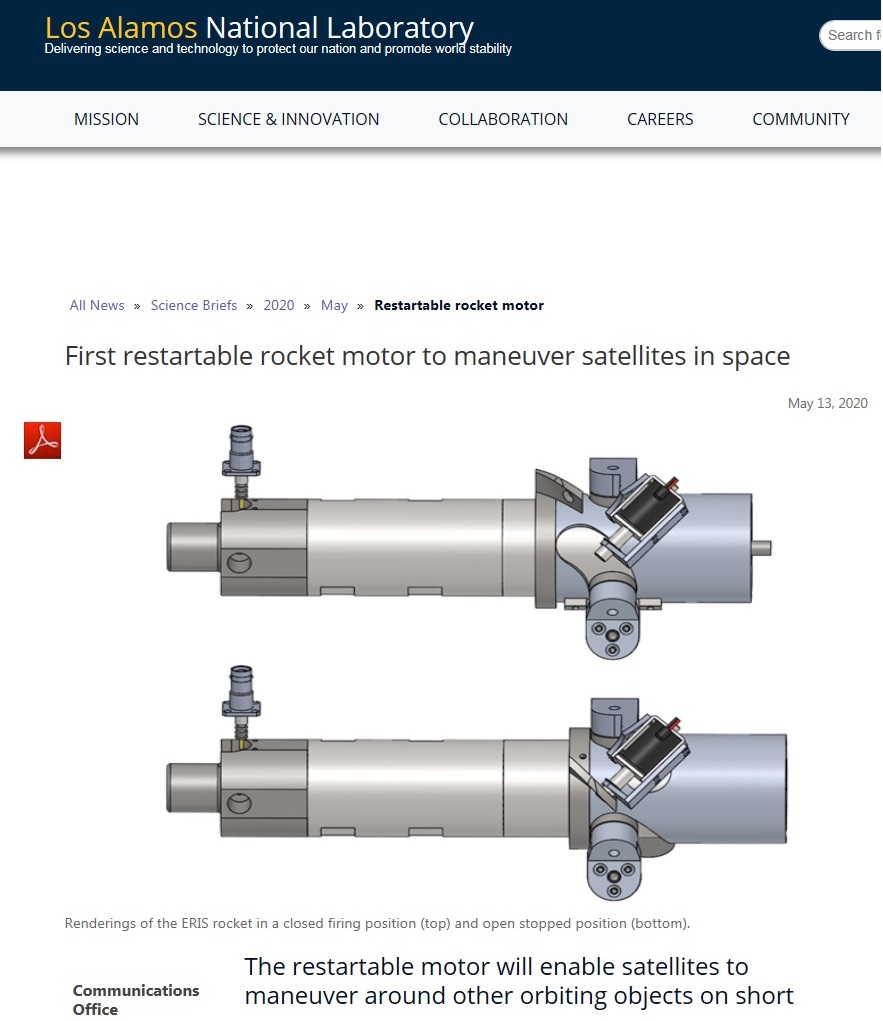Даже порох гаснет

Лос-Аламосская национальная лаборатория (LANL) при Департаменте энергетики США сообщила о разработке перезапускаемого твердотопливного ракетного двигателя. Запатентованная конструкция была проверена в лабораторных условиях, где инженерам LANL удалось шесть раз подряд включить и выключить двигатель.
Согласно LANL, двигатель имеет систему, управляющую давлением струи газов. Для этого предусмотрена специальная цилиндрическая камера. В момент, когда необходимо выключить двигатель, камера проворачивается таким образом, что её внутреннее пространство резко расширяется. Из-за падения давления газов порох гаснет. О том, какая для этого нужна пороховая смесь, к сожалению, не сообщается.
На рисунке изображена конфигурация двигателя в режиме работы и после остановки. Для его запуска предусмотрены система электролиза воды и свеча зажигания.
Изобретение предлагается для маневрирующих ракет и спутников как средство коррекции орбиты.
По мнению «Энерговектора», поскольку информация явно оборонного характера была опубликована открыто, она может представлять собой «утку», выпущенную для того, чтобы сбить конструкторов космических систем в других странах с толку и вынудить их потратить время на бесперспективное направление.
Обнаружив, что с сайта LANL заметка уже удалена, но всё ещё остаётся в кэше поисковой системы Google, мы скопировали её исходный текст - для наших самых любознательных читателей. Прилагаем этот текст.
The restartable motor will enable satellites to maneuver around other orbiting objects on short notice, preventing costly space crashes
Los Alamos researchers developed the first-ever restartable motor for solid rockets. With the patented design, the scientists and engineers were able to demonstrate restarting the motor at least six times in succession. All other solid rocket motors in use are a "one and done" scenario for maneuvering in space.
This new technology will help solve the increasing problem of space traffic, as more small satellites (such as the Los Alamos CubeSats) are sent into orbit. The restartable motor will enable satellites to maneuver around other orbiting objects on short notice, preventing costly space crashes.
A second high-priority defense application of this invention is missile maneuvering.
"Solid fuel-propelled missiles equipped with this technology will be able to perform multiple independent burns that will allow them to reach their targets through atypical non-ballistic flight paths," said Ian Shelburne of the High-Energy Science and Technology group.
Multi-burn solid rocket system
Solid rockets are an attractive choice because they are simple, low-cost, and scalable. However, traditional solid rockets are limited to one burn of fixed impulse for maneuvering. The Los Alamos researchers addressed this limitation by designing a multi-burn solid rocket system coupled with a re-usable ignition system.
"We developed an aerospike nozzle at Los Alamos with an actuated cowl," said Nicholas Dallmann, lead research engineer (MPA-Quantum). "Once a burn has achieved the desired velocity change, the cowl would rapidly open, decompressing the chamber and extinguishing the burn. When another burn of the rocket is needed, the cowl is reset to its original position."
This engineering enhancement greatly expands the usefulness of solid rockets. It will also help limit the amount of space debris that threatens national security satellites and instrumentation.
Electrolysis ignition is safe and environmentally sound
The Los Alamos researchers designed a safe, reusable ignition system that relies on the electrolysis of water instead of volatile pressurized chemicals. This enhances the safety of material handling as well as the safety of any flight crew and the environment.
The water is separated into hydrogen and oxygen through electrolysis. These are sent to the combustion chamber, where a spark ignites the gas. This can occur over and over for multiple burns. Re-ignition is one of the key features of this technology.
This system is also stable for very long periods (multiple decades), ideal for the lifetime of space flight or storage of a missile.


























